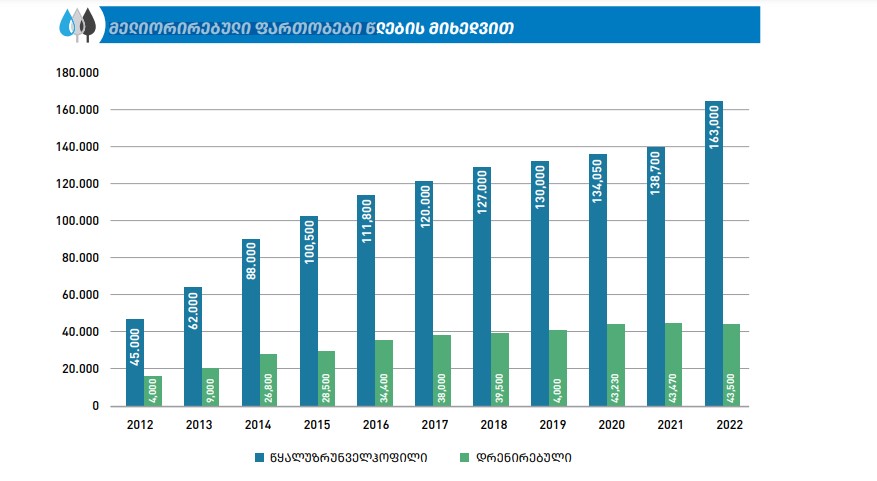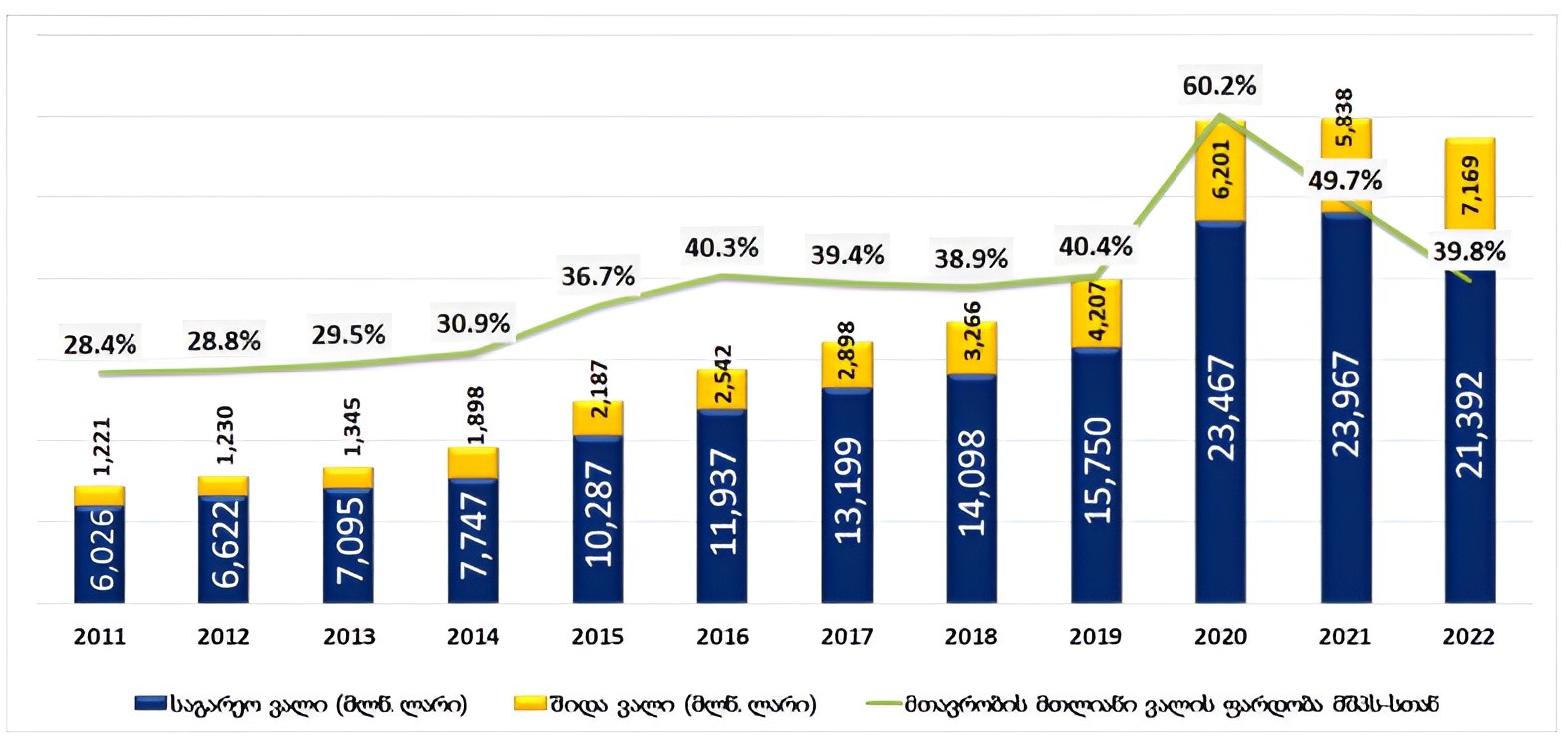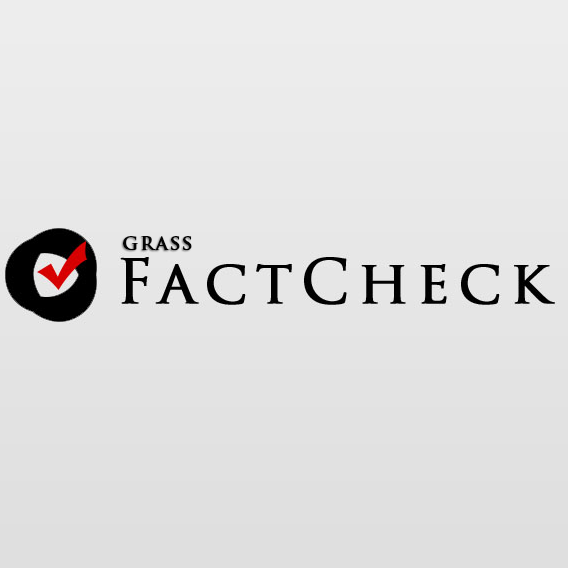The Georgian PM Irakli Gharibashvili presented the 2023 Government Performance Report on December 18, highlighting the achievements of the political party “Georgian Dream” but omitting the prevalent issues of the country.
Although the Prime Minister presented the yearly report, a significant portion of the economic and other indices were compared to those of 2012. Obviously, the “achievements” will sound more impressive if analysed over the longer term [10-11 years]. FactCheck believes that assessing the standard of living or evaluating the state of the economy by comparing it to the situation 11 years ago is irrelevant, especially under the context of the annual Government Performance Report. This report is expected to put more emphasis on the events of the past year.
Factcheck has evaluated the accuracy of the main statements made in the Prime Minister’s speech.
Irakli Gharibashvili: “The country’s entire economy, GDP was approximately GEL 27 billion [in 2012]; today, this year, GDP amounted to GEL 80 billion, expected to further increase to GEL 86 billion in 2024. The Georgian economy has tripled from GEL 27 billion to GEL 80 billion over the last 11 years under the governance of the “Georgian Dream”.
Verdict: HALF TRUE
The volume of the GEL-denominated nominal economy was GEL 27.2 billion in 2012. As for the expected indices, the aforementioned value was projected to increase by 2.9 times in 2023 reaching GEL 79.4 billion, and GEL 86 billion in 2024.
A tripled economy does not necessarily imply a tripled standard of living, considering the increase in consumer prices over the last few years, particularly in the recent period.
Moreover, the GEL to USD exchange rate has increased by 62%, rising from 1.65 to 2.67, which further impacted the nominal economy growth.
To truly reflect a tripled economy, it would require a 200% increase, meaning the 2023 economy should have been 1.6 times the 2012 economy (60% more) and approximately 1.7 times more in 2024 (68% more), taking inflation and exchange rate fluctuations into account.
Graph: GDP Growth (2012=100%)

Source: National Statistics Office of Georgia and Ministry of Finance of Georgia
Nominal values, even if numerically accurate, tend to provide an inflated impression without additional information. In reality, the real income of the population has not tripled. Thus, FactCheck concludes that this statement in Irakli Gharibashvili’s speech is HALF TRUE. Refer to FactCheck’s article for further information.
Statement 2: “The budget exceeded eight billion in 2012 at just under 8.500 billion; it is planned to further rise to 28.700 billion in the next year. We have tripled the budget in the past 11 years, increasing the total consolidated budget by 20 billion.”
Verdict: HALF TRUE
The consolidated budget includes those of autonomous republics and municipalities.
The consolidated budget income (including all types of income, such as taxes, grants, loans, privatisation, other income) totalled GEL 8.6 billion in 2012; the 2024 planned value constitutes 3.3 times more, expected to reach GEL 28.4 billion. A similar relationship is projected in the government budget as well – a three-fold increase from GEL 8.2 billion to GEL 24.6 billion.
While the aforementioned values are nominally accurate, similar to the GDP discussion, Irakli Gharibashvili once again omits the crucial effects of inflation, singificantly altering the actual picture, especially in the long term.
Consumer prices have risen by 64% from 2012 to 2023, and the 2024 consumer prices are expected to increase by 66% considering a three-percent inflation rate, meaning that the purchasing power associated with GEL 8.6 billion in 2012 is the same as that of GEL 14.3 billion in 2024. Taking inflation into account, the consolidated budget will have increased by 99% in 2012-2024, implying a two-fold rather than a three-fold increase. Similarly, the real growth rate of the government budget reduces from 200% to 80%, meaning that the aforementioned variable increased by 1.8 times rather than three.
Statement 3: “Poverty reduced to 15%, reaching a historic minimum. Poverty has, basically, halved over the 11 years. Over half a million people escaped poverty compared to 2012.”
Verdict: MOSTLY TRUE
The Prime Minister refers to data from the National Statistics Office of Georgia. It is worth to note that absolute poverty indicates the share of the population living under the subsistence minimum, thus in extreme poverty.
According to the 2022 data by GeoStat, 15.6% of the Georgian population, thus 582.9 thousand people live under the absolute poverty line. The level of poverty has decreased by a one-point-nine percentage point compared to the previous year. Overall, absolute poverty in Georgia has decreased from 30% to 15.6% under the governance of the “Georgian Dream”, leading to over 532 thousand people escaping absolute poverty since 2012. It is important to note that there was a positive trend in poverty reduction when the “Georgian Dream” initially came into power.
A historic minimum of absolute poverty indeed occurred in 2022. Thus, the data presented by the PM is accurate, however, despite a positive trend, the statement lacks an emphasis on the initial positive trend that was already observed before their government majority. Moreover, poverty remains one of the primary challenges of the country. The statement needs further clarification that the discussion revolved around extreme poverty rather than the overall poverty rate.
Considering all of the aforementioned factors, FactCheck concludes that the Prime Minister’s statement is MOSTLY TRUE.
Statement 4: “According to World Justice Project, Georgia ranks first in the Rule of Law index in Eastern Europe and Asia and hold the sixth position amongst middle-income countries.”
Verdict: HALF TRUE
The international organisation “World Justice Project” (WJP) annualy releases the Rule of Law index, evaluating the state of the rule of law across 142 countries. Each country is assigned a score ranging from zero to one, with zero indicating an extremely negative adherence to the rule of law and one indicating the strongest.
It is worth to note the methodology adopted to calculate the aforementioned index, which encompasses various factors, including 1) constraints on government powers, 2) absence of corruption, 3) open government, 4) fundamental rights, 5) order and security, 6) regulatory enforcement, 7) civil justice, 8) ccriminal justice. The conceptual framework of the index measures each component independently and draws an aggregate index.
As of today, Georgia ranks the 48th position with a score of 0.60 amongst 142 countries regarding the Rule of Law index, ranking first in Eastern Europe and Central Asia. It is important to underline that Georgia has consistently ranked first in these regions since 2015. Additionally, it is also accurate that Georgia holds the sixth position amongst above-middle-income countries as of 2023.
Further to note, the aforementioned index has significantly varied since 2015. Georgia assumed the highest index in 2015 at 0.62 and ranked 29th globally. Georgian rule of law was once again evaluated at a 0.65 score in 2016, however, was surpassed following the other countries improving their performance, thus taking the 34th ranking rather than 29th. In the following years, Georgia began to regress in terms of the Rule of Law coefficient, moving down towards the 38th position in 2017 and 2018 with a 0.61 score, and the 41st position in 2019 with the same score of 0.61. Further regression was observed in 2020 as Georgia ranked 42nd with 0.60 points, and dropped even further down on the 49th position in 2021, despite slight progress (0.61 score). In recent years, the index once again reduced to 0.60, however Georgia kept its 49th position in the ranking (for further information regarding Georgia’s performance in the Rule of Law index, refer to FactCheck’s article 1, article 2).
Evidently, despite Georgia ranking first in Eastern Europe and Central Asia, and sixth amongst middle-income countries, the index score has worsened since 2015. Emphasising the 2015 results in the context of the annual performance report gives an inaccurate impression of improved current-year situations leading to the aforementioned achievement.
Keeping the aforementioned into account and the Prime Minister’s omission of the overall negative trend, FactCheck concludes that the statement is HALF TRUE.
Statement 5: “45,000 hectares of land were irrigated in 2012. This area has increased to 163,000 hectares in the last 11 years.”
Verdict: FactCheck concludes that this statement is TRUE.
According to the 2022 report of the Ministry of Environmental Protection and Agriculture of Georgia, 423 reclamation infrastructure projects were implemented across Georgia, including the rehabilitation of 2,058 km of irrigation and 1,292 drainage canals, 53 head facilities, and 47 pumping stations.
The cleaning and fixing procedures of reclamation canals spanned across 19,200 km, and 23,964 various hydrotechnical structures were repaired. As a result, the area of water-provided land in Georgia increased from 45,000 hectares to 163,559 hectares. Additionally, 5,767 hectares of land are irrigated outside the intended bounds of irrigation projects.
Moreover, the area of land covered with drainage canals increased from 14,000 hectares to 43,469 hectares. According to the report, the operation of rehabilitated pumping stations and the repair of an irrigation network will supply water to villages that had not been irrigated for decades.
39 reclamation infrastructure projects were implemented in 2022 alone, totalling GEL 13.2 million (including the 30 projects independently implemented by companies at a cost of GEL 2.1 million).
Graph: Reclaimed Areas by Years

Source: Ministry of Environmental Protection and Agriculture of Georgia
Keeping the discussion above into account, the 45,000 hectares of irrigated land increased 3.6 times to 163,559 hectares. Thus, the Prime Minister Irakli Gharibashvili’s statement is TRUE.
Statement 6: “Georgia faced over 3,000 cases before the European Court of Human Rights in 2011. This figure has reduced to 147 by 20 times this year, obviously, underscoring the accuracy of the current administration of the Penitentiary Service.”
Verdict: FactCheck concludes that Irakli Gharibashvili’s statement is FALSE.
Irakli Gharibashvili compares the legal challenges faced by Georgia in the European Court of Human rights in 2011 to that of 2023 in the aforementioned statement. The term “current cases” reflects the cases faced by Georgia across various sections of the European Court, representing the total number of cases at the end of each respective time period. Additionally, the list accounts for the cases from previous years that are pending hearing by the Court.
At the end of 2011, the legal challenges faced by Georgia indeed amounted to 3,000, or 3,045 to be more specific. However, this number also encompasses the cases that were pending review from the previous years, majority of which (counting over 1,700) were strategic complaints against Georgia due to Russia’s malevolent campaigns following the 2008 war. Therefore, the statistical parallel drawn by the Prime Minister is not accurate.
The vailidity of methodology is further refuted by the fact that data collection procedures of the two mentioned time frames differed significantly, thereby inflating the number of accounted cases due to various reasons under the previous government. For instance, since 2012 a number of reforms were implemented in response to the Court’s efficient functioning being impeded by overcrowding. These reforms have effectively reduced the challenges associated with overcrowding.
Keeping all of the above into account, Irakli Gharibashvili omits various crucial factors affecting the statistics of the European Court, which have changed drastically changed the picture. This makes it impossible to compare different time frames and link the downward trend in the number of cases only to the internal politics of the country. Thus, FactCheck concludes that the Prime Minister’s statement is FALSE.
See FactCheck’s article for further information.
Statement 7: “The government debt has reduced to 38.2% [related to GDP]. I would like to remind you that the government debt exceeded 60% three years ago, and we have managed to significantly reduce government debt in minimal time.”
Verdict: HALF TRUE
Government debt is calculated with two parameters – absolute numerical values and with a ratio to GDP. The latter is considered more important, as the same value of debt might be challenging for Georgia but insignificant for China.
The government debt relative to GDP amounted to 60.2% in 2020, which then reduced to 49.7% in 2021, and further to 39.8% in 2022. The debt-to-GDP ratio was 38.2% as of November 2023. While the Prime Minister’s statement is contentually accurate, a critical factor has been omitted, drastically altering the context.
The year 2020 was an exception. The ratio of government debt to GDP fluctuated between 28% and 40% in the period from 2011 to 2019. The economy contracted by 6.8% in 2020, leading to the necessity of taking additional debt to cope with the pandemic and economic crisis. Moreover, these events were followed by a significant reduction in the value of GEL (depreciation) as well.
To note further, the PM puts great emphasis on drawing parallels to the 2012 values of GDP, budget, exports, wages and other important variables in his statement. Each of the listed variables are expected to naturally increase on a year-to-year basis, even under a slower rate of economic growth, thus using them to back up claims about significant achievements would not be accurate. The ratio of debt to GDP was an exception as its 2012 value was 10 percentage points less and amounted to 28.4%.
Graph: Absolute Values and Ratios of Government Debt

Source: Ministry of Finance of Georgia
The PM’s choice of 2020, a pandemic year, as the base year for comparison, and the expansion of the debt not only in absolute values but also relative to GDP by 10 percentage points, has led FactCheck to conclude that Irakli Gharibashvili’s statement is HALF TRUE. Refer to FactCheck’s article for further information.
Statement 8: “I would also like to note that in indices, such as absence of corruption, Georgia has ranked 33rd globally, making it into the top 20 countries in Europe, and first in Eastern Europe and Central Asia.”
Verdict: FactCheck concludes that Irakli Gharibashvili’s statement is HALF TRUE.
Analysis:
The international organisation “World Justice Project” (WJP) annualy releases the Rule of Law index, evaluating the state of the rule of law across 142 countries. Each country is assigned a score ranging from zero to one, with zero indicating an extremely negative adherence to the rule of law and one indicating the strongest. The index encompasses numerous components, including absence of corruption.
Georgia received a score of 0.68 and ranked 33rd in 2023, indeed being surpassed by only 19 European countries. It is also accurate that Georgia ranked first in Eastern Europe and Central Asia. However, despite Georgia consistently keeping its top position in the region since 2015, the performance has worsened from 0.73 to 0.68 in the eight years.
Due to the Prime Minister’s emphasis only on positive achievements and omission of the worsened tendency in performance since 2015, FactCheck concludes that Irakli Gharibashvili’s statement is HALF TRUE.
Statement 9: “Unemployment was approximately 27% in 2012. Unemployment reduced to 17%, its historic minimum, last year. A reducing trend of unemployment persisted in the three quarters of the current year, with the rate amounting to 15.6% in the third quarter.”
Verdict: HALF TRUE
First and foremost, unemployment rate is calculated as the ratio of unemployed people to economically active population [workforce]. Workforce encompasses both employed and unemployed individuals, currently seeking employment. According to the methodology of GeoStat, a person who is currently unemployed but also is not actively seeking employment is considered outside the work force, thus not categorised as unemployed. Therefore, the unemployment rate tends to technically decrease as the workforce decreases.
According to the GeoStat data, unemployment rate in Georgia amounted to 17.3% in 2022, and 26.7% in 2012.
Although the employment and work force indicators improved in 2022 compared to the pandemic period of 2020 and 2021, the indicators of the previous period [2015-2019] were not fully restored. However, despite 2022 indeed experiencing the historically minimal rate of unemployment, this was due to the fact that the economically active portion of the population significantly decreased in the longer term. To put it more simply, a considerable part of the population stopped seeking employment altogether or left the country.
Therefore, claiming that unemployment was at its historic minimum in 2022 is overestimated and does not reflect the objective truth (refer to FactCheck’s article).
Regarding the quarterly data of the current year, employment parameters indeed improved [relative to the analoguous parameters of the respective quarter in the previous year] (refer to FactCheck’s article).
The number of employed people increased by 7.7 (0.6%) in the third quarter, constituting 1366.3 thousand. In the same period, the number of unemployed people increased by over 1.4 thousand (0.6%), totalling 252.2 thousand.
Evidently, while both the values of employed and unemployed population increased almost identically, this was due to the expansion of the work force by 9.1 thousand (0.6%) in the third quarter of 2023 compared to the same period last year. Therefore, the number of employment-seeking individuals increased in the country with a part of them successfully finding employment and others joining the unemployed.
Graph: Work Force Indicators, Quarterly

Source: National Statistics Office of Georgia
Unemployment rate has remained 15.6% similarly to the same period last year, as of the data of quarter III, 2023. Employment rate grew insignificantly by 0.1 percentage points, totalling 45.3% in the same period.
Therefore, the Prime Minister accurately identifies the data while discussing unemployment and employment, however, overstates the “achieved progress”. Thus, FactCheck concludes that the aforementioned part of Irakli Gharibashvili’s report is HALF TRUE.








